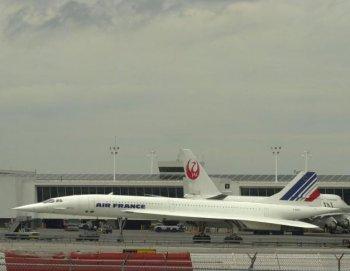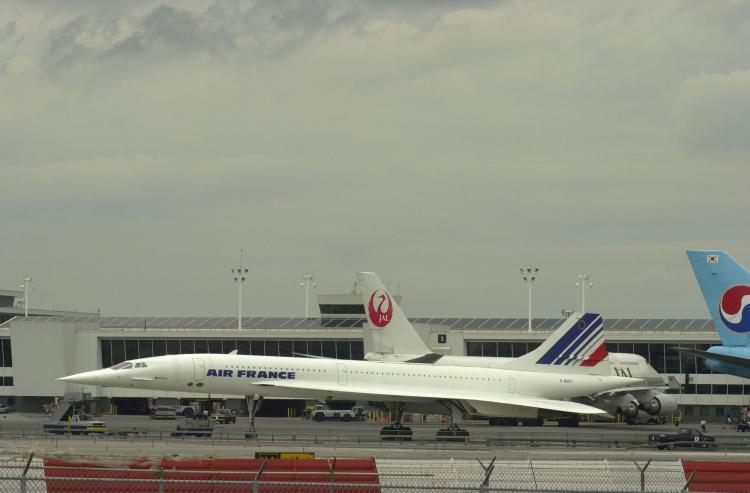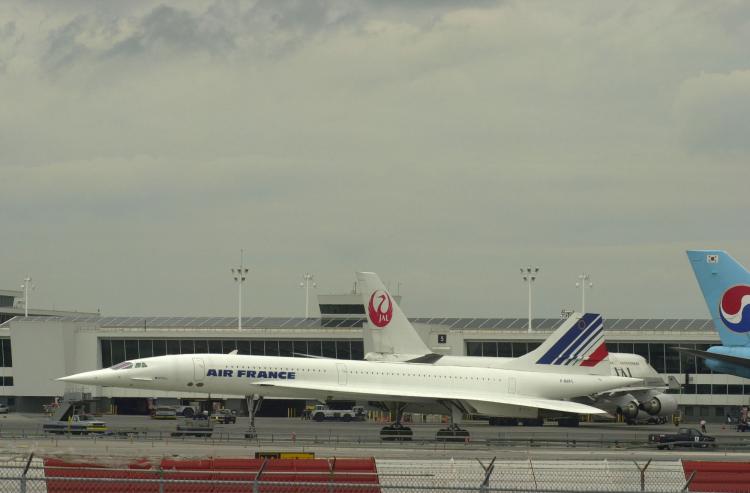A French court found Continental Airlines criminally responsible for the 2000 Concorde disaster that killed more than 100 people.
In a verdict released Monday, the court blamed U.S.-based Continental Airlines as well as a Continental mechanic for the plane crash. Investigators found that the crash was caused by a metal part that fell off a Continental DC-10 aircraft that took off 5 minutes earlier. The Concorde ran over the metallic strip, which punctured its tire and caused the jet to crash less than 1.5 minutes later.
Continental was fined 200,000 euro ($266,000) for the crash as well as ordered to pay a further 1 million euro ($1,330,000) to Air France in compensation, which operated the now-defunct Concorde.
The court also found Continental mechanic John Taylor guilty of negligence in his job maintaining the titanium metal strip that fell from the Continental DC-10 plane. He was fined 2,000 euro ($2,670) and given a 15-month suspended prison sentence.
The July 25, 2000 Air France Flight 4590 Concorde crash killed all 109 on board the supersonic jet, as well as four people on the ground when the plane crashed into the hotel La Patte d’Oie near Gonesse, France. The hotel was completely destroyed in the accident.
The metal strip that caused the accident had been replaced in Houston on July 9, according to Bureau of Enquiry and Analysis for Civil Aviation Safety (BEA) investigators’ final report published in January 2002.
“The strip installed in Houston had neither been manufactured nor installed in
accordance with the procedures as defined by the manufacturer,” the report concluded.
Following recommendations by investigators, the certificates of Airworthiness for the Concorde were suspended over the risks connected to the destruction of its tires.
The jets did fly again, but only until October 2003, never able to fully recover from the damage to its reputation after 2000 crash.
Three former French aviation officials as well as two Continental employees were acquitted on charges alleging negligence in the Concorde crash.
Continental Airlines called the ruling by the French court “absurd” and rejected accusations that it was responsible for the fiery crash, claiming it was being made a scapegoat.
“Portraying the metal strip as the cause of the accident and Continental and one of its employees as the sole guilty parties shows the determination of the French authorities to shift attention and blame away from Air France, which was government-owned at the time and operated and maintained the aircraft, as well as from the French authorities responsible for the Concorde’s airworthiness and safety,” Nick Britton, airline spokesperson, said in a statement.
Air France issued a one-sentence reaction to the ruling on its website. “Air France, plaintiff in the Concorde trial, welcomes the decision of the criminal court which recognizes Continental’s full criminal and civil liability in the Concorde accident.”
The Concorde was able to fly at twice the speed of sound. An average London to New York flight took under 3.5 hours, compared to about 8 hours for an average aircraft, cruising at a speed of 1350 mph, according to the British Airways website. Only 20 Concorde planes were ever built through the cooperation of France’s Aérospatiale and the British Aircraft Corporation. British Airways and Air France were the only airlines to fly the jet over its 27-year commercial flight history.
In a verdict released Monday, the court blamed U.S.-based Continental Airlines as well as a Continental mechanic for the plane crash. Investigators found that the crash was caused by a metal part that fell off a Continental DC-10 aircraft that took off 5 minutes earlier. The Concorde ran over the metallic strip, which punctured its tire and caused the jet to crash less than 1.5 minutes later.
Continental was fined 200,000 euro ($266,000) for the crash as well as ordered to pay a further 1 million euro ($1,330,000) to Air France in compensation, which operated the now-defunct Concorde.
The court also found Continental mechanic John Taylor guilty of negligence in his job maintaining the titanium metal strip that fell from the Continental DC-10 plane. He was fined 2,000 euro ($2,670) and given a 15-month suspended prison sentence.
The July 25, 2000 Air France Flight 4590 Concorde crash killed all 109 on board the supersonic jet, as well as four people on the ground when the plane crashed into the hotel La Patte d’Oie near Gonesse, France. The hotel was completely destroyed in the accident.
The metal strip that caused the accident had been replaced in Houston on July 9, according to Bureau of Enquiry and Analysis for Civil Aviation Safety (BEA) investigators’ final report published in January 2002.
“The strip installed in Houston had neither been manufactured nor installed in
accordance with the procedures as defined by the manufacturer,” the report concluded.
Following recommendations by investigators, the certificates of Airworthiness for the Concorde were suspended over the risks connected to the destruction of its tires.
The jets did fly again, but only until October 2003, never able to fully recover from the damage to its reputation after 2000 crash.
Three former French aviation officials as well as two Continental employees were acquitted on charges alleging negligence in the Concorde crash.
Continental Airlines called the ruling by the French court “absurd” and rejected accusations that it was responsible for the fiery crash, claiming it was being made a scapegoat.
“Portraying the metal strip as the cause of the accident and Continental and one of its employees as the sole guilty parties shows the determination of the French authorities to shift attention and blame away from Air France, which was government-owned at the time and operated and maintained the aircraft, as well as from the French authorities responsible for the Concorde’s airworthiness and safety,” Nick Britton, airline spokesperson, said in a statement.
Air France issued a one-sentence reaction to the ruling on its website. “Air France, plaintiff in the Concorde trial, welcomes the decision of the criminal court which recognizes Continental’s full criminal and civil liability in the Concorde accident.”
The Concorde was able to fly at twice the speed of sound. An average London to New York flight took under 3.5 hours, compared to about 8 hours for an average aircraft, cruising at a speed of 1350 mph, according to the British Airways website. Only 20 Concorde planes were ever built through the cooperation of France’s Aérospatiale and the British Aircraft Corporation. British Airways and Air France were the only airlines to fly the jet over its 27-year commercial flight history.






